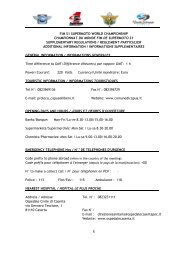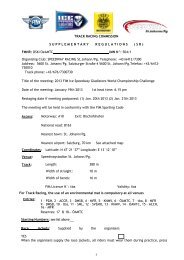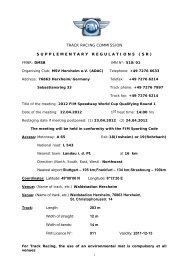TECHNICAL RULES MOTOCROSS (INCLUDING RULES FOR ... - FIM
TECHNICAL RULES MOTOCROSS (INCLUDING RULES FOR ... - FIM
TECHNICAL RULES MOTOCROSS (INCLUDING RULES FOR ... - FIM
You also want an ePaper? Increase the reach of your titles
YUMPU automatically turns print PDFs into web optimized ePapers that Google loves.
The use of a lanyard attached to the rider to operate this breaker as an alternative to<br />
a button is recommended.<br />
The general circuit must also include a second general circuit breaker which shall be<br />
located behind the rider, positioned and easily recognised taking into account that the<br />
vehicle may be on one side following an incident. This circuit breaker must be<br />
operated by a red button and identified with a yellow disc (minimum 8 cm in<br />
diameter) reading 'Emergency' in red or black letters.<br />
The options suggested below are acceptable, as are other solutions that meet the<br />
stated requirements. Teams will be required to demonstrate the operation of the<br />
Emergency Stops during technical inspection.<br />
1. A low voltage switch (e.g. push button) as a control for a contactor relay in which<br />
the contactor can be mounted down near the motor and keep the power voltages<br />
and currents away from the rider and top side of the vehicle.<br />
2. A relay with an integrated “breaker” switch, which requires running the full battery<br />
voltage to wherever this breaker is mounted.<br />
Operation of the general circuit breaker must also isolate any pre-charge resistors, if<br />
installed.<br />
In order to prevent contact melting of the general circuit breaker its ampere square<br />
seconds characteristics, representing heat energy dissipated on the breaker contacts<br />
during switching, must be sufficient to guarantee proper operation of the circuit<br />
breaker, even under surge current conditions, in particular those occurring during the<br />
connection of the accumulator to the power plug.<br />
Low power accumulators provided for low voltage circuits, e.g. auxiliary circuits, do<br />
not have to be isolated by the general circuit breaker (Emergency Stop) provided that<br />
they are completely isolated from the main power accumulators.<br />
50.04.8 Power Indicator<br />
When the vehicle is in a powered on state, there must be two clearly visible<br />
indicators, one light on the instrument panel and one light on the rear of the vehicle.<br />
The rear light must be red and visible from at least 10m away, from the side or rear,<br />
and must flash between 1 - 2 times / second on a 50% duty cycle.<br />
50.04.9 Fuses (over-current trip switches)<br />
An over-current trip is a device which automatically interrupts the electrical current in<br />
which it is installed if the level of this current exceeds a defined limit value for a<br />
specific period of time.<br />
Fuses and circuit breakers (but never the motor circuit breaker) count as over-current<br />
trips. Extra fast electronic circuit fuses and fast fuses are appropriate. The fuses must<br />
be in an easily accessible location and as close as possible to the accumulator at<br />
both polarities.<br />
20

















